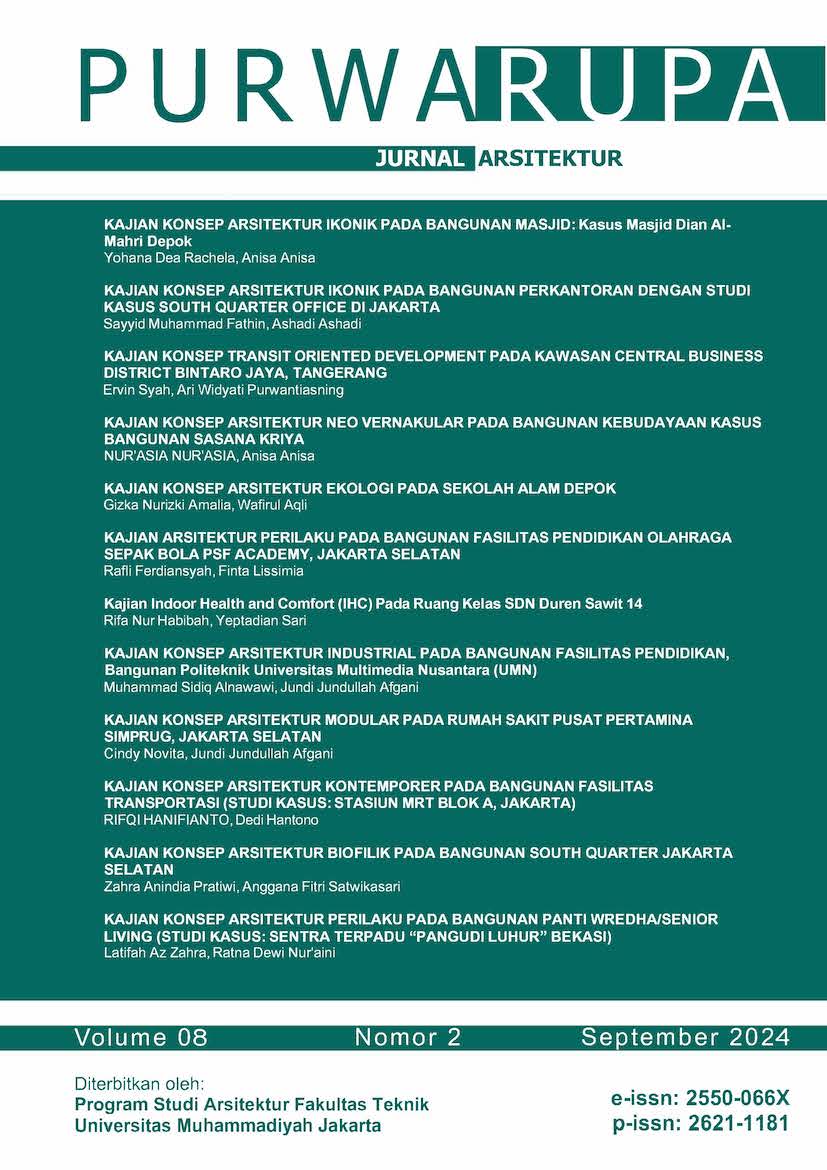KAJIAN KONSEP ARSITEKTUR IKONIK PADA BANGUNAN MASJID: Kasus Masjid Dian Al-Mahri Depok
DOI:
https://doi.org/10.24853/purwarupa.8.2.91-98Abstrak
ABSTRAK. Arsitektur adalah seni dan ilmu merancang. Dari segi desain, ide, dan material yang digunakan, arsitektur mengalami perkembangan yang pesat. Bangunan ikonik telah menjadi populer sebagai penanda suatu tempat atau penanda zaman di era arsitektur modern. Bangunan ikonik biasanya dibangun di lokasi strategis, seperti persimpangan jalan, taman, dan ruang terbuka atau tempat kumpul orang. Tak jarang masjid di Indonesia, bahkan di Jakarta, menggunakan konsep ikonik sebagai ciri khas tipologi paling penting dan berpengaruh dalam menafsirkan ajaran dan keyakinan inti agama ke dalam struktur mereka. Halaman terbuka, arcade, ruang sholat, dan menara adalah bagian dari Arsitektur Khas Masjid. Salah satunya adalah bangunan masjid. Penelitian ini menggunakan metode kualitatif, dengan pendekatan penelitian deskriptif sebagai jenisnya. Data primer dan sekunder digunakan dalam penelitian ini. Data primer berasal dari observasi studi kasus: Masjid Dian Al-Mahri. Data sekunder berasal dari literatur yang mendukung penelitian. Hasil dari tulisan ini dapat disimpulkan bahwa studi kasus bangunan yang diteliti yaitu pada Masjid Dian Al-Mahri dapat disebut bangunan Ikonik, karena pada bagian bangunan Masjid Dian Al-Mahri ini menerapkan prinsip-prinsip ikonik. Diantaranya seperti, skala bangunan yang relatif besar atau megah, bentuk bangunan yang akraktif dan menarik, kekuatan bangunan yang kokoh sehingga berumur panjang, dan letaknya yang strategis. Kata Kunci: arsitektur, ikonik, masjid ABSTRACT. Architecture is the art and science of designing. In terms of design, ideas, and materials used, architecture has experienced rapid development. Iconic buildings have become popular as markers of a place or markers of the times in the era of modern architecture. Iconic buildings are usually built in strategic locations, such as crossroads, parks, and open spaces or gathering places. It is not uncommon for mosques in Indonesia, even in Jakarta, to use iconic concepts as the most important and influential typological hallmark in interpreting the core teachings and beliefs of religion into their structure. Open courtyards, arcades, prayer halls, and minarets are part of the mosque's distinctive architecture. One of them is the mosque building. This research uses qualitative methods, with a descriptive research approach as its type. Primary and secondary data were used in this study. The primary data comes from the observation of a case study: Dian Al-Mahri Mosque. Secondary data come from literature that supports the study. The results of this paper can be concluded that the case study of the building studied, namely the Dian Al-Mahri Mosque, can be called an Iconic building, because the Dian Al-Mahri Mosque building applies iconic principles. Among them, such as, the scale of the building is relatively large or magnificent, the shape of the building is acractive and attractive, the strength of the building is sturdy so that it lives long, and its strategic location. Keywords: architecture, iconic, mosqueReferensi
Asrizal, D., Amiuza, C. B., & Nugroho, A. M. (2015). Museum Jembatan sebagai Bangunan Ikonik Pulau Madura. Jurnal Mahasiswa Jurusan Arsitektur Universitas Brawijaya, 167. http://arsitektur.studentjournal.ub.ac.id/index.php/jma/article/view/118
Azza, M. A. R., & Anisa, A. (2019). Kajian Arsitektur Simbolik Pada Bangunan Masjid. Jurnal Arsitektur PURWARUPA, 3(3), 213–220. https://jurnal.umj.ac.id/index.php/purwarupa/article/view/4464/3180
Dafrina, A. (2019). 7 ( Tujuh) Paradigma-Paradigma Dalam Berteori Arsitektur. Jurnal Arsitekno, 6(6), 22. https://doi.org/10.29103/arj.v6i6.1225
Donovan, F. I. (2020). HUNIAN VERTIKAL DI KECAMATAN WENANG , MANADO. 9(1), 197–206.
Pawitro, U. (2012). Perkembangan ’arsitektur ikonik’ di berbagai belahan dunia. Majalah Ilmiah TRI-DHARMA Kopertis Wilayah IV Jabar & Ban Ten, Bandung, Nomor:01/Tahun XXV/Agustus 2012, 01. http://www.academia.edu/download/32052061/Perkembangan_Arsitektur_Ikonik_Tri-Dharma_2012_Udjianto.pdf
Penulis : Nanik Ernawati Editor : Livana PH CV . Global Health Science Group (Issue October). (2023).
Ridwan, M., & Afgani, J. J. (2023). Kajian Konsep Arsitektur Kontemporer Pada Bangunan Masjid Al Irsyad. PURWARUPA Jurnal Arsitektur, 7(1), 9. https://doi.org/10.24853/purwarupa.7.1.9-14
Riza, M., Doratli, N., & Fasli, M. (2012). City Branding and Identity. Procedia - Social and Behavioral Sciences, 35(December 2012), 293–300. https://doi.org/10.1016/j.sbspro.2012.02.091
Rizqi, N. M. M. (2020). KAJIAN KONSEP IKONIK PADA BANGUNAN FASILITAS OLAHRAGA BENTANG LEBAR (Stadion Utama Gelora Bung Karno). Jurnal Arsitektur ZONASI, 3(2), 233–241. https://doi.org/10.17509/jaz.v3i2.24471
Sipil, F. T. (2012). Fakultas Teknik Sipil & Perencanaan. 2–5.
Sklair, L. (2006). Iconic architecture and capitalist globalization. City, 10(1), 21–47. https://doi.org/10.1080/13604810600594613
##submission.downloads##
Diterbitkan
Cara Mengutip
Terbitan
Bagian
Lisensi
COPYRIGHT POLICY
The author(s) of an article published in the Jurnal Teknologi retains ownership of the intellectual property rights in work (s).
PUBLISHING RIGHTS
The author(s) of an article published in the Jurnal Teknologi have unrestricted publication rights. The authors give the Jurnal Teknologi the right to publish the article and designate the Faculty of Engineering Universitas Muhammadiyah Jakarta Publishing as the original publisher of the article.
LICENSING POLICY
Journal of Mechanical Engineering and Sciences is an open-access journal that follows the Creative Commons Non-Commercial 4.0 International License (CC BY-NC 4.0), which states that:

Under this license, the reusers must give appropriate credit, provide a link to the license, and indicate if changes were made. Users may do so in any reasonable manner, but not in any way that suggests the licensor endorses users or their use.
Please take the time to read the whole license agreement (https://creativecommons.org/licenses/by-nc/4.0/). As long as reusers follow the license conditions, the owner cannot withdraw these freedoms. The following components are included under this license:
 Attribution: Users must provide appropriate attribution, including a link to the license, and indicate whether or not they made any modifications. Users are free to do so reasonably, but not in a manner that indicates the licensee approves of their usage.
Attribution: Users must provide appropriate attribution, including a link to the license, and indicate whether or not they made any modifications. Users are free to do so reasonably, but not in a manner that indicates the licensee approves of their usage.
 NonCommercial: Users may not use the material for commercial purposes.
NonCommercial: Users may not use the material for commercial purposes.

